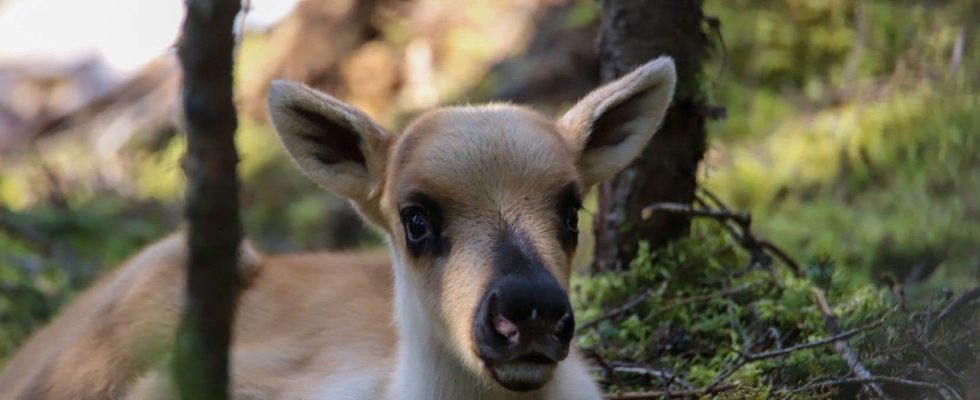The promoters of a major wind project wish to build wind turbines and paths in forest habitats which could serve as “refuges” for the last caribou of Charlevoix, note experts from the Ministries of the Environment of Quebec and Canada. This herd on the verge of extinction has been temporarily placed in an enclosure, and the Legault government promises to present a strategy to save the species this year.
The promoters of the “Des Neiges” project, namely Hydro-Québec, Boralex and Énergir, have been confronting experts from Environment and Climate Change Canada (ECCC) and the Ministry of the Environment, the Fight against Climate Change, for several months, of Wildlife and Parks (MELCCFP) on the question of the impacts of the installation of wind turbines for woodland caribou.
One of the three sectors of this project, named “Charlevoix”, provides for the construction of 60 to 80 wind turbines, of which at least 18 would be installed in the “distribution area” of the woodland caribou population of Charlevoix. This billion-dollar project would also require the construction of “several kilometers of roads” on the same territory. It is part of a project that will be the largest wind development in the history of Quebec, with possibly 180 wind turbines.
Over the course of multiple discussions that have taken place for almost a year with government scientists as part of the analysis of the impact study, the promoters repeat that their project “would have no impact” on the caribou. . They emphasize in particular that the energy production complex will be built on a territory which is already very “disturbed”, in particular by the forestry industry.
In the responses to questions and opinions from the departments, it is added that the project would have no impact on the federal government’s “recovery plan”, that no caribou have been spotted by telemetry in the “zone study” and that the herd has been kept “in enclosure” in the Grands-Jardins national park since winter 2022.
Births in captivity
Scientists specializing in deer at ECCC and MELCCFP respond that they “do not share the conclusions” of the promoters.
Due to the “significant rate of disturbance” in this range and the “low number of individuals”, they say they are “concerned about the residual effects associated with this project, particularly those associated with potential losses of essential habitats in the ‘range, as well as those linked to the loss of habitat connectivity’.
We add that, even if the habitat is very disturbed, “the desire of the Quebec government is to restore this habitat by limiting the addition of temporary and permanent disturbances, such as the installation of wind turbines, but also by providing active restoration efforts.” Predator control operations have also been carried out in recent years.
Caribou specialist and professor at the University of Quebec at Rimouski, Martin-Hugues St-Laurent shares the findings of government experts. “Even if the habitat is disturbed, this is not an excuse to add disturbances that will persist over time. If we move forward, we deprive ourselves of the possibility of restoring this habitat,” which is a necessary ecosystem for several other species.
For its part, the federal government wishes, as part of its “recovery plan”, to maintain the size of this population “and reduce the population to a minimum of 100 individuals to mitigate the risk of virtual disappearance”.
When the Charlevoix caribou were captured, 16 individuals were placed in an enclosure. The births of the last two springs brought this number to 31 animals, including 5 juveniles and 11 fawns, according to figures sent to the Duty. Reintroduced in the early 1970s, after disappearing, this population had reached 125 individuals by the early 1990s, before rapidly declining due to habitat degradation due to human activity.
“Shelters”
MELCCFP experts also predict that “the habitat that will be impacted by these wind turbines is made up of high plateaus, a habitat sought after by caribou. Furthermore, with climate change, these high plateaus risk becoming important refuges for this species, [en raison des] population changes linked to warming temperatures.
However, they emphasized in June that the promoter “did not evaluate the possibility of reviewing his project in order to completely avoid the establishment of infrastructure” within the distribution area, we can read in exchanges from recent months, published in the Quebec Environmental Assessment Register.
A MELCCFP document posted online on October 10 therefore once again asks that the project be “revised, in order to completely avoid the establishment of infrastructure within the distribution area” of the Charlevoix caribou.
The ministry adds that “the repercussions” of infrastructure on caribou can be felt “within a radius of up to 4 km” from it. What’s more, “in the specific case of wind turbines, the noise and movement of the blades can generate a modification of anti-predator behavior and ultimately an abandonment of optimal habitats”.
“Comprehensive” protection would therefore require that any wind turbine located in the distribution area as well as in the 4 km buffer zone be relocated, underlines the MELCCFP. In this context, the request from government experts to move only those located in the range “is already a compromise between the protection of a vulnerable species and the shift towards green energy”.
Do the promoters intend to develop the project completely outside of this suitable area? “The Charlevoix project is still in design. We are taking note of the ministry’s comments to improve the project as best as possible and, as with any project in development, we continue to evaluate the different possible configurations to minimize impacts on wildlife and the environment,” argues Boralex in a written response. to questions from Duty. The impact study, which is 566 pages long, was submitted a year ago now.
We still do not know what the Legault government plans to do with the Charlevoix caribou herd, which is currently in an enclosure of 0.2 square kilometers. The species protection strategy, repeatedly postponed in recent years, should be presented by the end of the year.
